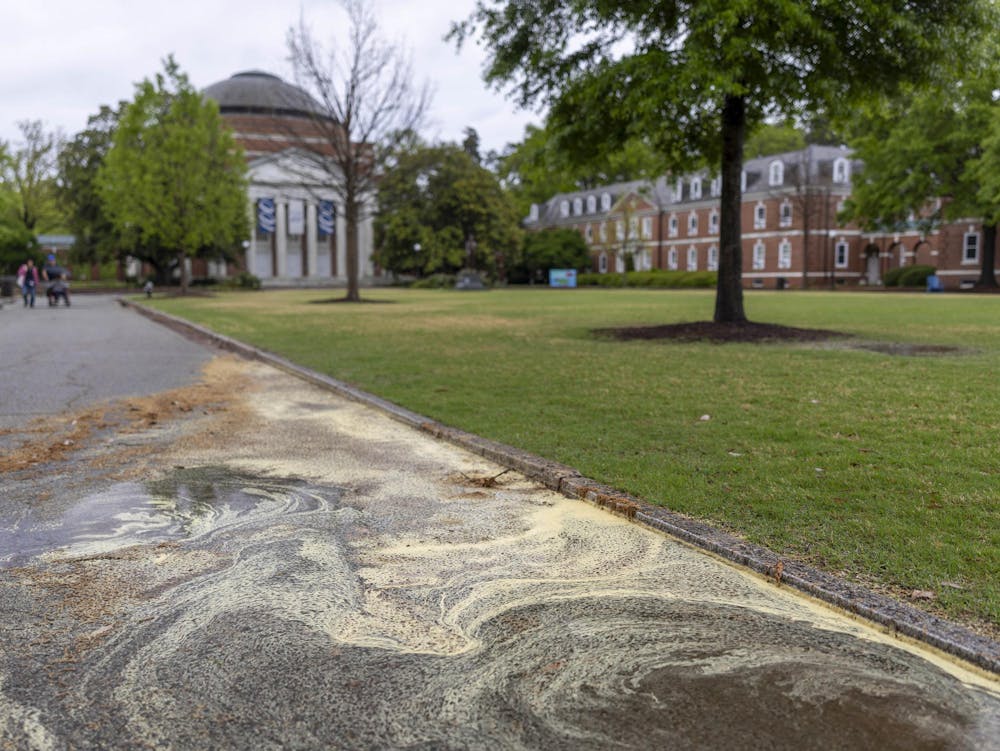Campus was adorned in white during January and February snowfalls. But in late March and early April, wafts of yellow-green coated every outdoor surface — cars, chairs and stairs alike.
The surge in pollen, felt by many community members with seasonal allergies, was no illusion. Pollen levels in North Carolina reached record levels last month, which experts attributed to forces driven by a changing climate.
“The season is longer and the plants are producing more pollen. … We are certainly on track in 2025 to have another record high,” said Patricia Lugar, allergy and immunology specialist and associate professor of medicine and pediatrics, adding that 2024 also set pollen density records in the state.
Lugar further noted that pollen density in North Carolina has been on the rise in recent years. The North Carolina Division of Air Quality measured that March had the highest level of grass pollen since 1999, the year the organization started collecting data.
Lugar evaluates data from pollen measuring stations across the state, including stations in Raleigh and parts of eastern and western North Carolina. The stations determine pollen count by noting how many grains of pollen can be collected in a “certain amount of airspace.”
This National Allergy Map, which shows pollen severity nationally, displayed Durham and most of North Carolina at “high” pollen levels as of Monday. According to the Asthma and Allergy Foundation of America, Raleigh and Greensboro are in the top ten allergy capitals.
According to Lauren Jenkins, doctoral candidate in ecology at the Nicholas School of the Environment, climate change is the main driver of the increase in pollen intensity. She explained that warmer temperatures result in longer growing seasons, which cause plants to begin pollinating earlier and continue pollinating for longer.
“Research has shown that higher [carbon dioxide] levels can cause plants to produce more pollen,” Jenkins wrote in a Thursday email to The Chronicle. “Weather patterns like mild winters followed by warm springs could also contribute to a more concentrated release of pollen.”
She added that windy weather can contribute to pollen dispersal and that light rain can stimulate plant growth, resulting in an increased pollen release.
The increased pollen intensity is expected to continue amid worsening climate change, Jenkins noted. She shared that by 2050, pollen counts in the United States could double from their 2000 levels, with the Southeast receiving the brunt of the impact.
Jenkins explained that the University’s proximity to the Duke Forest, which has dense quantities of pine and oak trees, could contribute to campus pollen levels. Still, its impact is “comparable to other wooded areas in Durham, meaning it’s not necessarily worsening pollen counts beyond what’s typical for the region.”
Though some may suspect that the abundant plant life in the Sarah P. Duke Gardens contributes to campus pollen levels, Jenkins described the gardens as having a “minimal effect.”
Dealing with seasonal allergies
Sophomore Kiara Lavana described her experience with the pollen season as “being sick for a month straight” and waking up with congestion each morning. She sometimes wore sunglasses to prevent pollen from irritating her eyes, and once resorted to covering her face with a scarf.
Though Lavana also experienced allergies in her home state of Massachusetts, she said that allergy medication was able to quell the discomfort. In Durham, however, she can “see the pollen everywhere and feel it in [her] eyes,” adding that “nothing really helps except staying inside.”
First-year Leah Yu, who hails from Ohio, similarly described how she found it difficult to walk outdoors without having to itch her eyes, noting that she was “completely unprepared for how much pollen there would be in the South.” She added that pollen allergies have “taken a toll” on her academic performance, such as when working on her group projects.
“[The symptoms impede] with our thought processes and our collaborative efforts if one of us is always getting up and trying to throw away tissues or go to the bathroom,” Yu said.
Lugar shared that beginning in late March and throughout April, the “allergy group” at Duke Health typically experiences an uptick in patients and requests for evaluations to help manage allergy symptoms.
She noted that common seasonal allergy symptoms include nasal congestion, runny nose, sneezing and itchy, watery eyes. Others may experience post-nasal drip, a cough, and even an asthma response, hives or itching.
Lugar recommended that those experiencing allergy symptoms start with over-the-counter medications, such as nasal sprays, saline irrigation and oral antihistamines. Students who have tried these medications can seek out more specific relief methods, along with allergy testing, allergen immunotherapy and sublingual tablets, at the Duke Asthma, Allergy and Airway Center.
Get The Chronicle straight to your inbox
Sign up for our weekly newsletter. Cancel at any time.
Other tips include avoiding peak pollen days and times, generally between 10 a.m. and 2 p.m. Lugar also suggested using an air purifier and keeping windows closed to avoid pollen settling in dorms.
Bhavika Verma is a Trinity first-year and a staff reporter for the news department.

